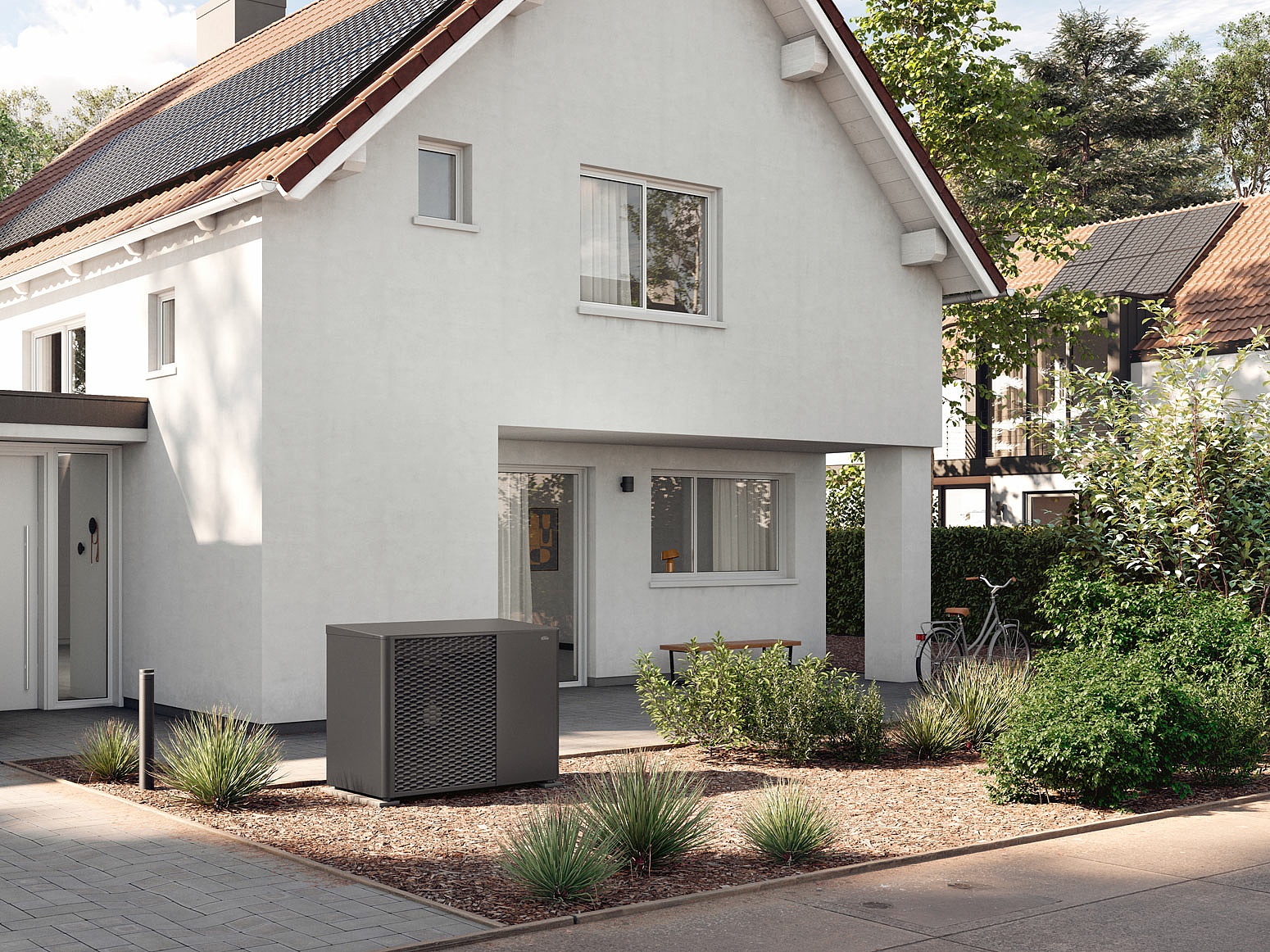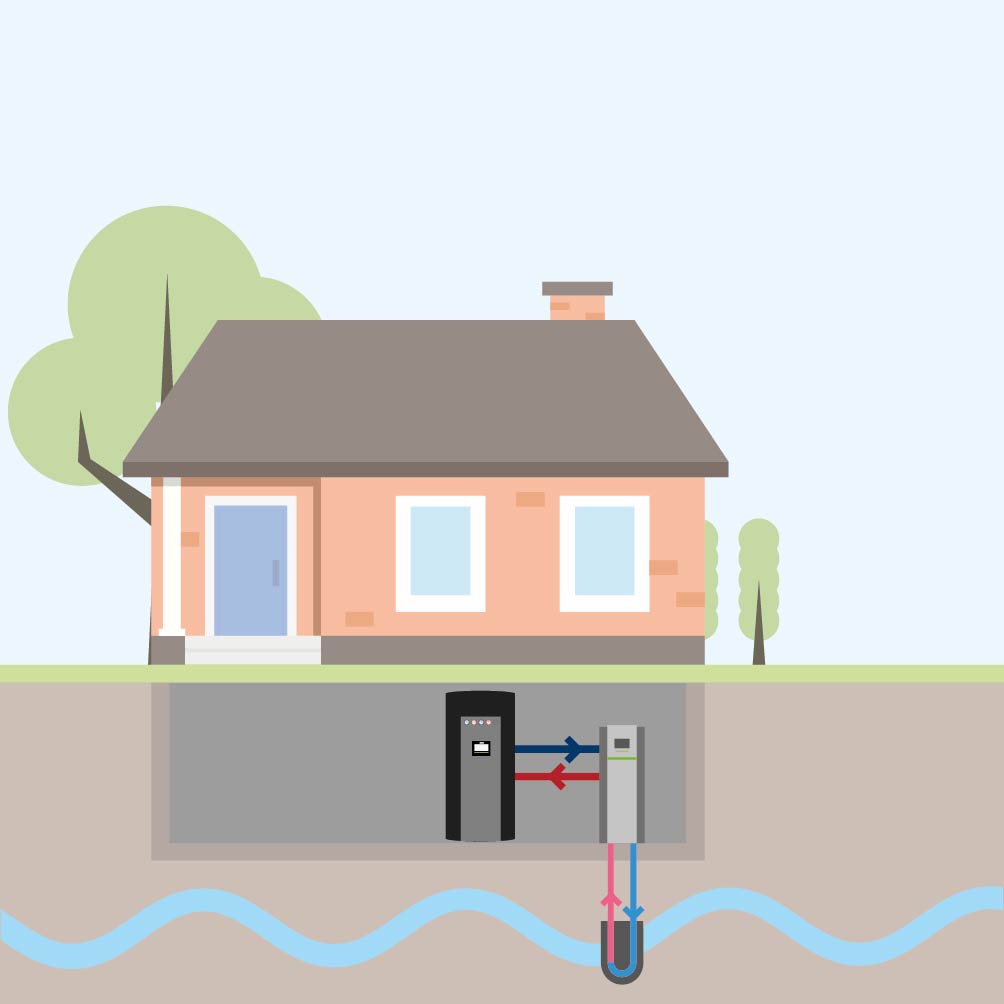Things worth knowing about heat pumps
With an eye for what’s important.

Benefits of the x-change heat pump.
In contrast to conventional heat pumps, most x-change heat pumps have an adjustable modulation width, which allows for a variable output. The speeds of fans and charging pump can be also be controlled in line with this. This means the best possible degree of efficiency can be attained in the partial load range, which is often required. Modulation is managed by the heat pump manager.
The radial fan is extra-large, allowing it to run more slowly. This reduces the drive noises and makes the x-change heat pump virtually silent.
Most x-change heat pumps are connected using the reliable Plug & Heat principle. Instead of simple terminals, coded connectors and defined connection sizes make installation easier. This virtually rules out incorrect installation and therefore the risk of hydraulic defects.
With the KERMI eccolution refurbishment concept, the KERMI x-optimised system can even be connected up to old one-pipe systems during renovation.
With the energy manager and the associated temperature module, x-change heat pumps allow you to optimise the use of PV electricity you have produced yourself.
For the environment. And for the future.
The heat pump is currently the most future-oriented form of energy production.
Based on the emission-free use of geothermal heat and solar energy, it is firmly focused on green energy.
It is efficient and, over the long term, impressively sustainable.
x-change heat pumps are perfectly designed within the heating system to attain the maximum energy-saving volume – with the maximum heat output. This means that x-change heat pumps guarantee the most comfortable climate possible and are also impressively good to the environment.
The use of 3/4 air or geothermal heat (to generate heat energy) and 1/4 eco-electricity (to drive the pump) uses 100 % green, fully renewable energy – without compromise.
Sustainable and efficient, the x-change heat pump is the key component of the KERMI x-optimised system.
Thanks to seamless interaction between the individual components, this ensures better heat storage (x-buffer heat storage), more intelligent control (x-center), and more efficient transmission into the individual rooms through optimised panel heating (x-net) or steel panel radiators (therm-x2). And it is powerful enough to provide comfortable, feel-good warmth, even with conventional radiators, convectors, and designer radiators.

Did you know that...

…a heat pump only needs 1 kW of conventional electrical output to generate around 4 kW of heat output?
This means that, in comparison to conventional heating technologies, heat pumps offer significant savings and the electricity they use is converted much more efficiently.
If the electricity also comes from renewable energy sources or cogeneration, the carbon emissions are reduced and the heat pumps reveal their ecological benefits in full.
This is a particularly important point in view of plans for the proportion of renewable energy in the power mix to continue growing. By 2020, the stated objective of the German government is for this share to be 35 %, and by 2030, as much as half of all generated electricity is intended to come from renewable sources.
This means that the heat pump is a heating system that will become increasingly environmentally friendly in the long term.
Operating mode. It’s that simple. And that clever.
A heat pump essentially works in the same way as a refrigerator. While refrigerators dissipate heat from the inside to the outside according to the principle of heat and power, a heat pump extracts thermal energy from the ground, groundwater, or surrounding air and converts it into heating warmth or, in the case of a drinking water heat pump, into clean domestic hot water. This is based on a closed circuit consisting of an evaporator, compressor, condenser, and expansion valve.
In contrast to conventional heat pumps, most models in the x-change series have a wide modulation range, which means the output can be controlled. The speed of the fan and storage charging pump can be controlled to coordinate with this. Above all, modulation ensures that the best possible degree of efficiency is achieved in the partial load range, which is often required.
Operating modes
Various operating modes are available so that a heat pump can be used to maximum effect in practice:
Monovalent operation
The heat pump is the only heat generator in a building.
Bivalent operation
There is a second heat generator in addition to the heat pump.
In this case, there is the option of bivalent-parallel operation (in which both generators work from a predefined outside temperature) and bivalent-alternative operation (the heat pump and alternative generators operate alternately).
Monoenergetic operation
The heat pump works up to a predefined outside temperature. If the outside temperature is lower than this, an electric screw-in heater switches on as well.
Both heat generators are operated with the same type of energy (electricity).
Types of heat pump
Air
Air
The heat pump takes the heat energy out of the air.
It can be set up inside or outside the building.

Water
Water
Heat pumps are also able to use the heat energy stored in groundwater.

Ground
Geothermal collectors
Heat generation with geothermal collectors is also possible.
There are two main methods of heat generation from the ground: one that uses a panel collector and another that uses a geothermal probe.
In both systems, a heat transfer liquid circulates in the pipelines. The flowing medium absorbs the heat in the ground and transfers it to the heat pump.

Geothermal probe
A geothermal probe extracts the heat energy stored in the ground.
Guide
Lautstärke und Schallschutz
Mit ihrer besonders effektiven Schall- und Schwingungsdämpfung entwickeln unsere Wärmepumpen kaum mehr Geräuschemission als ein tickender Wecker.
Eigenverbrauch optimieren
Stromkosten senken mit Solaranlage, Stromspeicher und der x-change Wärmepumpe.
Mit der Wärmepumpe kühlen?
Egal ob Luft/Wasser-, Sole/Wasser- oder Wasser/Wasser-Wärmepumpe - Wärmepumpen lassen sich auch zur Kühlung der Wohnräume einsetzen, wenn die notwendigen technischen Voraussetzungen erfüllt sind.
Wärmepumpe und Photovoltaik kombinieren
Es ist es durchaus sinnvoll, eine Wärmepumpe und eine Photovoltaikanlage zu kombinieren: Wärmepumpen brauchen zum Betrieb konventionellen Strom - eine PV-Anlage gewinnt Strom aus der Sonnenenergie. Und x-change dynamic Wärmepumpen haben serienmäßig eine PV-Schnittstelle integriert.
Welche Wärmepumpe ist die richtige?
Großes oder kleines Grundstück, Einfamilien- oder Mehrfamilienhaus – welche Wärmepumpe die richtige für das eigene Bau- oder Modernisierungsprojekt ist, hängt vor allem von den Voraussetzungen im und am Haus ab. Ein paar grobe Eckdaten und Einordnungen helfen bei der Auswahl.
